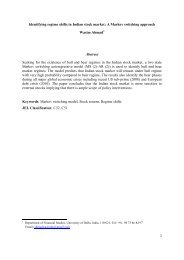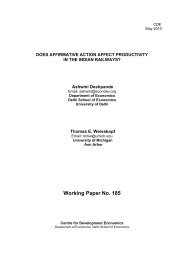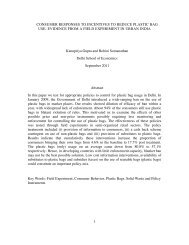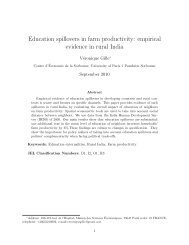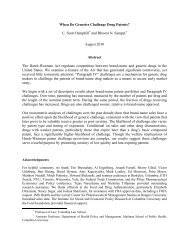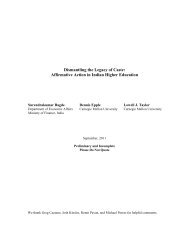Stochastic Dynamic Models for Political Regime Change and ...
Stochastic Dynamic Models for Political Regime Change and ...
Stochastic Dynamic Models for Political Regime Change and ...
You also want an ePaper? Increase the reach of your titles
YUMPU automatically turns print PDFs into web optimized ePapers that Google loves.
• Asymmetric perception of failure rate: In<strong>for</strong>mation does not reach all equally well.<br />
If perceived ”fail” is low <strong>for</strong> some people, does it help longer tenures?<br />
Suggested solution: introduce a stochastic ”f”. Higher variance (more in<strong>for</strong>mation asymmetry,<br />
feature of LDCs) ⇒ longer tenure?<br />
• Population growth: If all groups grow equally, then no change in proportions <strong>and</strong> results<br />
unchanged.<br />
If Z grows faster than X or Y, then may assume Z has net growth, X & Y stationary. Also<br />
the reverse case. Results to be studied.<br />
X, Y grows at rate α 1 <strong>and</strong> Z grow at rate α 2 . Then cases to be considered are<br />
(i) α 1 = α 2<br />
(ii) α 1 > α 2<br />
(iii) α 1 < α 2 .<br />
• Episodic event: War or Natural Calamity. Should have both short term <strong>and</strong> long term<br />
impact. May be modelled by ”delay” equations.<br />
5 Concluding Remarks<br />
When outcomes of developmental projects undertaken are uncertain, ruling parties in a democracy<br />
often face a difficult choice. Taking up projects that fail result in bad publicity <strong>and</strong> hence<br />
a dent in the vote bank. But on the other h<strong>and</strong> a successful project leads to more votes as well<br />
as more money in the funds. In the context of a two party model of democracy with neutrals<br />
<strong>and</strong> supporters, we set up a dynamic stochastic model to explore this situation.<br />
Using numerical methods, we show that the rate of failure of projects play a crucial role in<br />
changing the probability of a reelection. We also explore the role of other factors like rate of<br />
project arrival, party loyalty <strong>and</strong> changeover probability. We have studied the unconditional <strong>and</strong><br />
conditional (fixing the value of other parameters at different levels) effect of all the parameters<br />
on the probability of change. The results throw up some interesting patterns on joint effects<br />
that are quite intriguing <strong>and</strong> calls <strong>for</strong> further research.<br />
The results indicate that in a strategic setting, in some situations, the ruling party would be<br />
better off by ensuring a low rate of project arrival to increase their chances of reelection. This<br />
has interesting implications <strong>for</strong> addressing the development vs. political stability conundrum.<br />
The model that we have considered here relies on three alternative <strong>for</strong>mulations of the<br />
uncertainty inherent in the situation under study. The results are accordingly more or less<br />
sensitive to changes in the value of the parameters. A comparative study of this has also been<br />
made.<br />
In the sequel we have pointed out some possible future directions of research in this area.<br />
there are many interesting alternatives to be explored both theoretically or numerically as well<br />
as empirically using available databases or primary data specifically collected <strong>for</strong> this purpose.<br />
13



